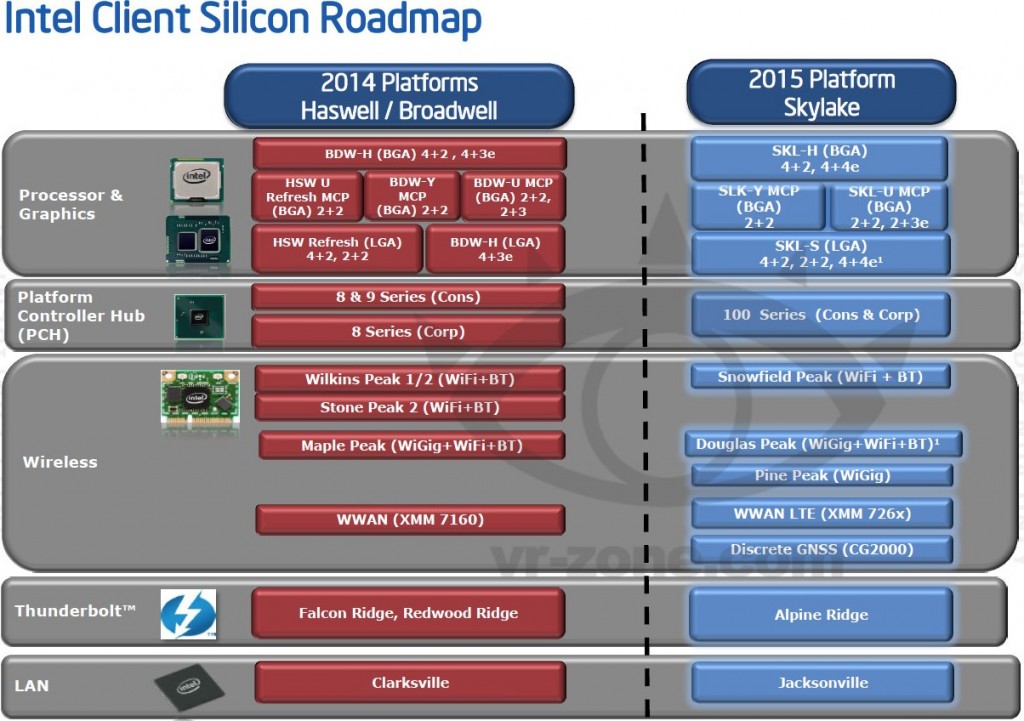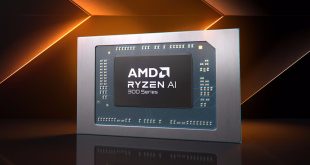As previously reported, despite of the delay of the code-named Broadwell lineup of central processing units, Intel Corp.’s code-named Skylake chips are on-track to be introduced in 2015. Since preparations for introduction of the new platform are already underway in south-east Asia, the first leaks about the Skylake and systems on its base have begun to emerge.
Just like predecessors, Intel Skylake microprocessors will be available in multiple versions designed for different applications. Based on an image, which resembles slides from Intel’s roadmaps, published by the Chinese version of VR-Zone web-site, Intel Skylake will exist in at least eight basic versions (which will differ from each other by thermal design power, number of cores, packaging, etc.) designed for four different classes of client PCs. There will be three types of Skylake chips – Skylake H, Skylake-U and Skylake-Y – that will come in ball-grid array (BGA) packaging and will be aimed at all-in-one desktops/SFF desktops, mainstream laptops and ultra-thin notebooks, respectively. There will be Skylake-S chips that will come in land-grid array (LGA) form-factor designed mostly for desktops.
It is interesting to note that mainstream Skylake processors for clients will continue to have two or four cores, there will be no mainstream chips for desktops and notebooks with six or eight x86 engines even in 2015, so expect Skylake-E to offer six and eight core options sometime in 2016.
The Skylake central processing units for client PCs will offer three types of graphics cores: GT2, GT3e with embedded DRAM cache and GT4e with embedded DRAM cache. At present it is unknown whether the graphics cores of Intel Skylake support all DirectX 12 capabilities, but that is a likely scenario.
The Skylake microprocessors will rely on Intel 100-series chipsets, which are projected to support SATA Express as well as PCI Express 3.0 interconnection technologies. The Skylake-E will likely support PCI Express 4.0 for next-generation discrete graphics adapters.
While high-performance Skylake microprocessors will use DDR4 memory, low-power versions will continue to utilise DDR3L and LPDDR3 memory next year, probably because by the time Skylake chips hit the market there will be no DDR4L memory with reduced power consumption in sufficient quantities.
The next-gen Skylake client platform due in 2015 will also be accompanies with numerous connectivity and I/O options, such as Snowfield Peak (Wi-Fi, Bluetooth), Douglas Peak (WiGig, Wi-Fi, Bluetooth), Pine Peak (WiGig), Alpine Ridge (Thunderbolt 3.0 with 40Gb/s transfer rate), Jacksonville Ethernet, next-generation XMM726x-series WWAN 4G/LTE modem and so on. All those chips and solutions will help PC manufacturers to make Skylake-based personal computers even more feature rich from connectivity standpoint.
Not a lot is known about Intel’s Skylake micro-architecture in general. It is known that Skylake will feature a bunch of special-purpose accelerators, will support such technologies as AVX 3.2 (512-bit instructions), SHA extensions (SHA-1 and SHA-256, secure hash algorithms), MPX (memory protection extensions), ADX (multi-precision add-carry instruction extensions) and other innovations. However, it is unknown whether Skylake is designed to boost performance or further cut-down power consumption.
Intel did not comment on the news-story.
Discuss on our Facebook page, HERE.
KitGuru Says: The main intrigue about Skylake now is when exactly Intel plans to introduce them. In case the slide is correct, then it looks like the new chips will be widely available in 2015 (otherwise Skylake would be called a 2016 platform), which suggests launch in the middle of the year. However, the company could introduce Skylake in time for the back-to-school season (BTS), which means wide availability only in late 2015.
 KitGuru KitGuru.net – Tech News | Hardware News | Hardware Reviews | IOS | Mobile | Gaming | Graphics Cards
KitGuru KitGuru.net – Tech News | Hardware News | Hardware Reviews | IOS | Mobile | Gaming | Graphics Cards



